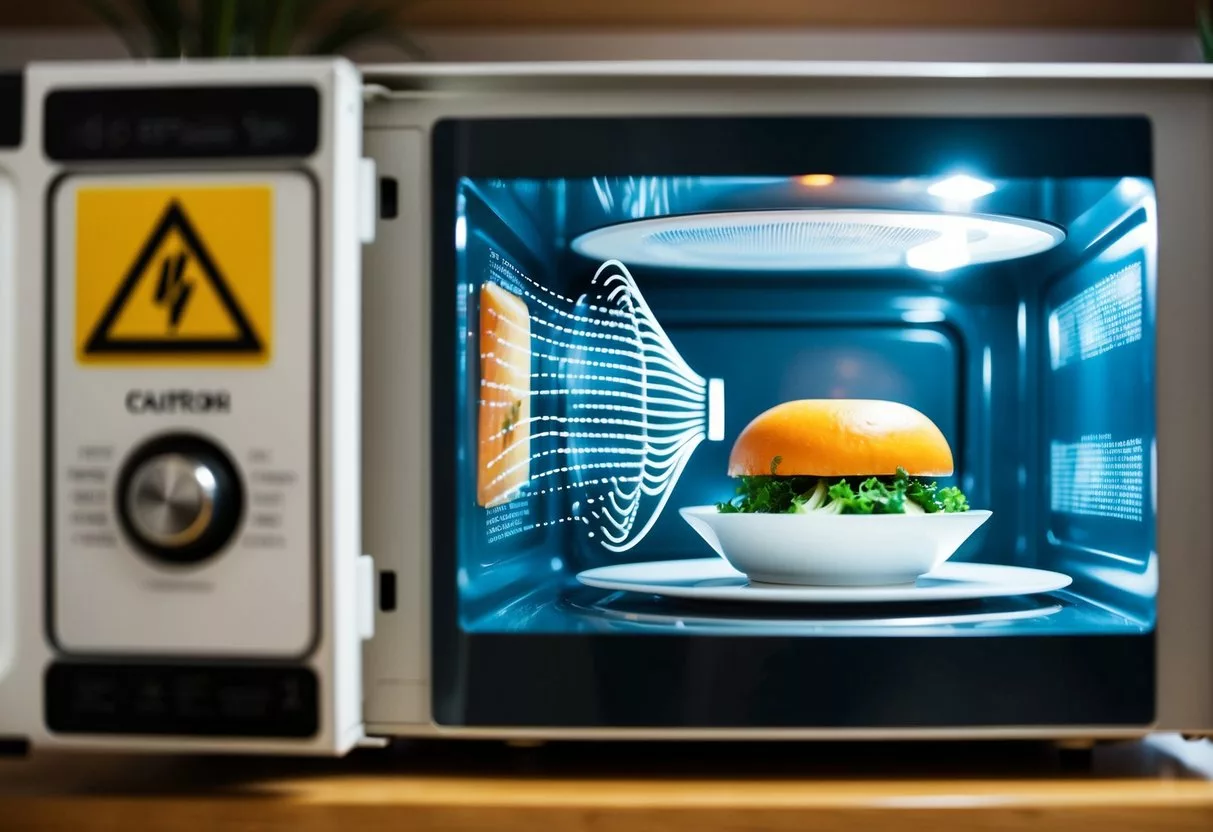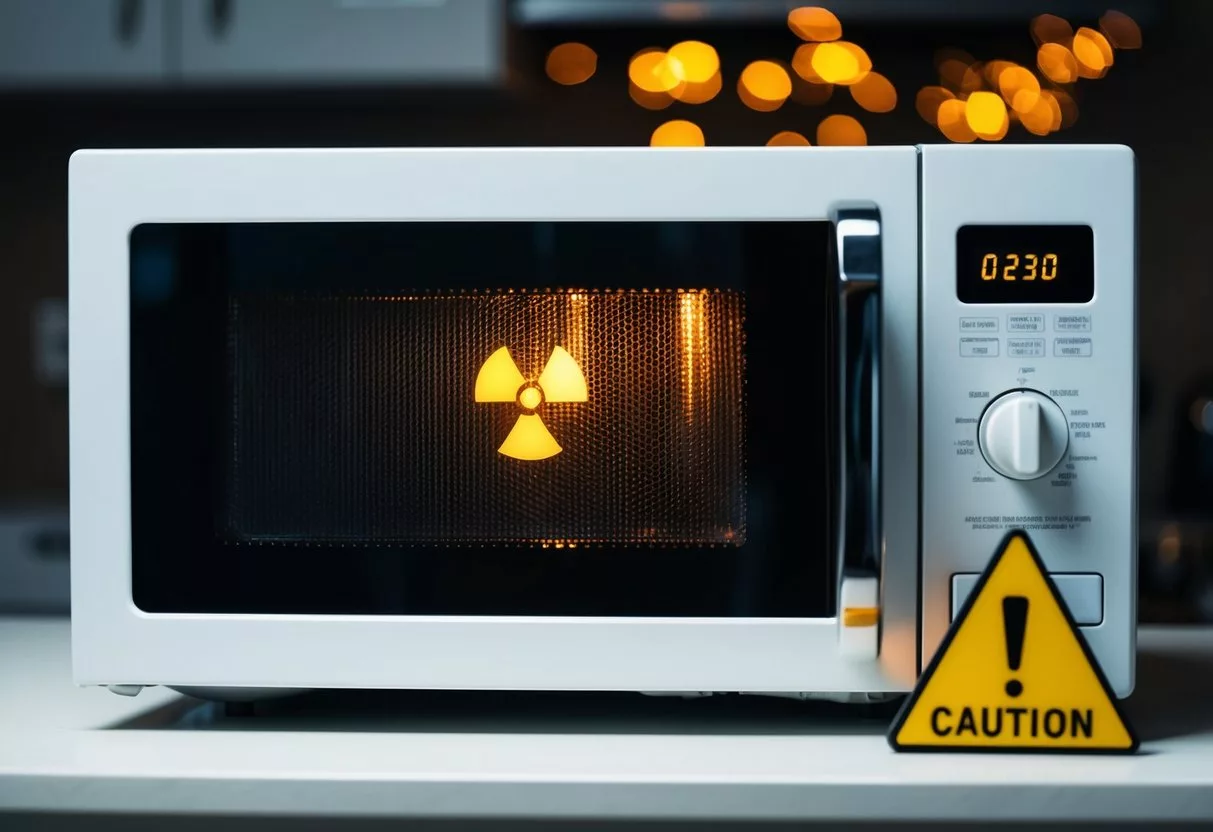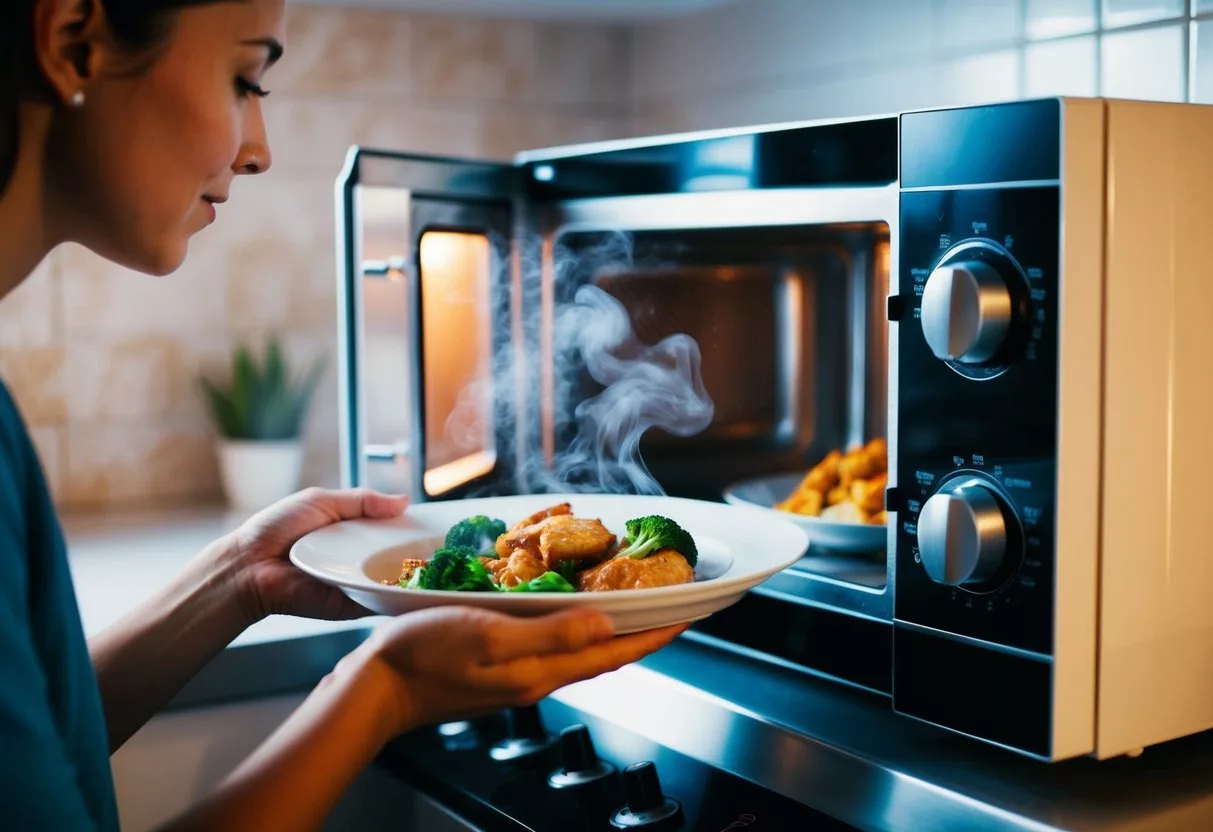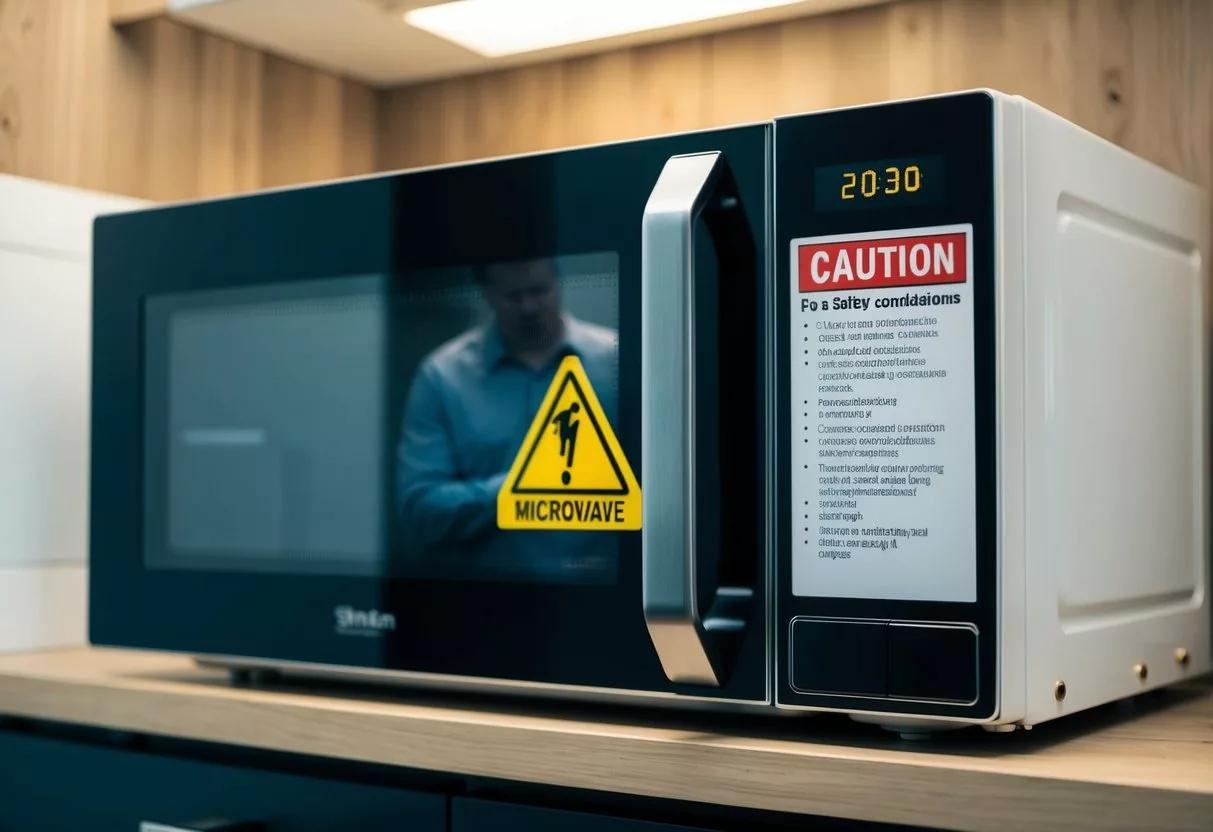Microwave ovens have become a common kitchen appliance in many homes. They offer quick and easy ways to heat food. But some people worry about their safety.

Microwave ovens do not make food radioactive or unsafe to eat when used properly. The radiation they use to heat food is different from the kind that can harm people. It only heats water molecules in food.
Still, it’s important to use microwaves correctly. This means using microwave-safe containers and following the instructions. By doing so, you can enjoy the benefits of this handy appliance without worry.
How Microwave Ovens Work

Microwave ovens are common kitchen appliances that use electromagnetic waves to heat food quickly and efficiently. They have several key components and come in different types to suit various needs.
Basic Functionality and Uses
Microwave ovens work by producing microwaves, a type of electromagnetic radiation. These waves cause water molecules in food to vibrate, creating heat. This process is called dielectric heating.
Microwaves are ideal for:
- Reheating leftovers
- Defrosting frozen foods
- Cooking vegetables
- Making popcorn
- Melting butter or chocolate
They are less suited for browning or crisping foods. Many people use microwaves daily to save time in food preparation.
Types of Microwave Ovens
There are several types of microwave ovens available:
- Countertop models: These are the most common and affordable.
- Over-the-range units: They save counter space and often include a vent hood.
- Built-in microwaves: These are integrated into kitchen cabinetry.
- Convection microwaves: They combine microwave and convection oven functions.
Sizes range from compact to large, with wattages typically between 600 to 1200 watts. Higher wattage usually means faster cooking times.
Microwave Oven Components
The main parts of a microwave oven include:
- Magnetron: This generates the microwaves used for cooking.
- Waveguide: It directs the microwaves into the cooking chamber.
- Cooking chamber: A metal box that contains the food and microwaves.
- Rotating turntable: This ensures even cooking by moving the food.
- Control panel: It allows users to set cooking times and power levels.
- Door with safety interlocks: This prevents microwave leakage during operation.
The microwave-safe cooking dish is also crucial. It should be made of materials that don’t absorb microwaves, like glass or ceramic.
Microwave Radiation and Health

Microwave radiation from ovens plays a key role in cooking food quickly. While this technology is widely used, questions about its safety persist. Let’s explore the nature of microwave radiation and its potential effects on health.
Characteristics of Microwave Radiation
Microwave radiation is a type of electromagnetic radiation. It has wavelengths between radio waves and infrared light. Microwaves can heat food by making water molecules vibrate.
Microwave ovens use this radiation to cook or heat food. The waves typically have a frequency of 2.45 GHz. This frequency is good for heating water in food but doesn’t penetrate deeply into most materials.
Microwaves from ovens are contained inside the appliance. Only a small amount may leak out. This leakage decreases rapidly with distance from the oven.
Non-Ionizing Radiation: Understanding the Basics
Microwave radiation is non-ionizing. This means it doesn’t have enough energy to remove electrons from atoms. It’s different from ionizing radiation like X-rays or gamma rays.
Non-ionizing radiation can’t directly damage DNA or cells. Its main effect is heating. At high levels, this heating could potentially cause harm. But microwave ovens use low power levels.
The health effects of non-ionizing radiation are still being studied. Current evidence doesn’t show clear health risks from properly functioning microwave ovens.
Regulations and Safety Standards
The FDA regulates microwave ovens in the United States. They set strict limits on radiation leakage. Ovens must emit no more than 5 milliwatts of radiation per square centimeter at about 2 inches from the oven surface.
Manufacturers must include safety features in ovens. These include door locks and automatic shut-offs. These features prevent the oven from operating when the door is open.
Regular testing ensures ovens meet safety standards. Users should check their ovens for damage. A damaged door or seal could potentially lead to higher radiation leakage.
Health Impacts of Microwave Cooking

Microwave cooking affects food in several ways. It can change nutrient content, potentially form harmful compounds, and impact bacteria levels. These factors are important to consider for health-conscious consumers.
Nutrient Retention Versus Traditional Cooking
Microwave cooking often preserves more nutrients than traditional methods. This is due to shorter cooking times and less water use. Vitamin C is especially well-retained in microwaved foods.
Some vegetables keep more antioxidants when microwaved. Broccoli, for example, maintains its cancer-fighting compounds better. Microwaving can also preserve minerals like potassium and magnesium.
However, not all nutrients fare equally well. B vitamins may be lost more easily in microwaved foods. The key is to use minimal water and avoid overcooking.
Potential for Harmful Compounds
Microwaving can sometimes create harmful substances in food. Heating certain fats can produce unhealthy trans fats. Microwaving meats may form more heterocyclic amines, which are linked to cancer risk.
Reheating some foods in plastic containers can release harmful chemicals. It’s best to use microwave-safe glass or ceramic dishes instead. Uneven heating in microwaves can also create hot spots where harmful compounds might form.
Despite these concerns, microwaving is generally considered safe. Using proper techniques can minimize risks.
Microwaving Food and Bacteria
Microwave cooking can effectively kill harmful bacteria in food. The heat generated destroys most microorganisms. This makes microwaving a good option for food safety.
However, uneven heating can leave cold spots where bacteria survive. It’s important to stir food and let it stand after microwaving. This allows heat to distribute evenly.
Some bacteria may be more resistant to microwave heating. Proper cooking times and temperatures are crucial. Using a food thermometer ensures food reaches safe temperatures throughout.
For best results, consumers should follow microwave cooking instructions carefully. This helps ensure food safety and optimal nutrient retention.
Cooking Methods and Nutrient Preservation

Different cooking methods affect the nutrient content of food. Microwaving, boiling, and frying each have unique impacts on food’s nutritional value. The cooking time and technique used can significantly influence nutrient retention.
Comparing Microwave Cooking to Boiling and Frying
Microwave cooking often preserves nutrients better than other methods. It uses less water and cooks food quickly, which helps retain vitamins and minerals. Boiling can cause nutrients to leach into the cooking water. Frying may destroy some nutrients due to high heat.
Microwaving broccoli keeps more vitamin C than boiling. Boiled vegetables lose water-soluble vitamins to the cooking liquid. Fried foods absorb oil, increasing calorie content.
A study found that microwaving vegetables in steamable bags preserved nutrients well compared to traditional cooking methods.
Effects on Broccoli and Other Vegetables
Broccoli and other vegetables react differently to various cooking methods. Microwaving broccoli can maintain its vitamin C and antioxidants better than boiling.
Steaming and microwaving generally preserve nutrients in vegetables more effectively than boiling. Carrots, for example, keep more carotenoids when microwaved than when boiled.
Some vegetables, like tomatoes, may benefit from certain cooking methods. Cooking tomatoes can increase the availability of lycopene, a beneficial antioxidant.
Optimizing Cooking Times for Nutrient Retention
Cooking time plays a crucial role in preserving nutrients. Shorter cooking times usually result in better nutrient retention.
For microwaving:
- Use minimal water
- Cook vegetables until just tender
- Avoid overcooking
Pressure cooking and microwaving can better preserve antioxidants in some vegetables compared to boiling. These methods cook food quickly, reducing nutrient loss.
Steaming vegetables for short periods often retains more nutrients than longer cooking times. This applies to both traditional steaming and microwave steaming methods.
Safety Considerations in Microwave Use

Microwave ovens are convenient, but proper use is very important for safety. Key areas to focus on include choosing appropriate containers, avoiding uneven heating, and ensuring food is thoroughly cooked.
Materials and Containers for Microwave Use
Selecting the right containers is vital for microwave safety. Glass, ceramic, and microwave-safe plastics are good choices. Avoid metal, which can cause sparks and damage the oven.
Some plastics may contain harmful chemicals like BPA and phthalates that can leach into food when heated. Look for containers labeled “microwave-safe” to avoid these risks.
Paper products like paper towels and plates are generally safe, but avoid using newspaper or brown paper bags. These can release chemicals or catch fire.
Styrofoam containers should not be used unless specifically labeled for microwave use. They can melt and contaminate food.
Preventing Uneven Cooking and Super-Heated Water
Uneven cooking is a common issue with microwaves. To prevent this, stir food halfway through cooking and let it stand for a few minutes after heating to distribute heat evenly.
Super-heated water is a dangerous phenomenon where water becomes hotter than its boiling point without bubbling. This can lead to sudden eruptions and burns.
To avoid super-heating:
- Use containers with rough surfaces
- Add a non-metallic object like a wooden spoon to the liquid
- Avoid over-heating
Food Safety and Undercooked Food
Microwaves can leave cold spots in food, leading to undercooked areas where harmful bacteria can survive. This is especially risky with meat, poultry, and eggs.
To ensure food safety:
- Use a food thermometer to check internal temperatures
- Rotate and stir food during cooking
- Let food stand for the recommended time after cooking
Proper food handling is necessary. Thaw frozen foods in the refrigerator, not the microwave, to prevent bacterial growth.
Cover foods to trap steam and promote even cooking. This also helps maintain moisture and prevents splatters that can harbor bacteria.
Consumer Guidance on Microwave Ovens

Microwave ovens offer quick and convenient cooking options for busy households. Proper selection, use, and maintenance can enhance safety and effectiveness.
Choosing the Right Microwave for Your Needs
When selecting a microwave, consider size and power. Compact models work well for small spaces, while larger ovens suit families. Wattage affects cooking speed and evenness.
Look for features like turntables and multiple power settings. These help food cook more evenly. Preset buttons for common items like popcorn can be handy.
Microwave safety features are important, especially in homes with children. Check for child locks and sturdy door latches.
Energy efficiency ratings can help reduce electricity costs. Compare models to find one that balances performance and energy use.
Best Practices for Microwave Cooking
Use microwave-safe containers. Glass, ceramic, and some plastics work well. Avoid metal, which can cause sparks.
Cover foods to prevent splatters and retain moisture. Use microwave-safe lids or paper towels.
Stir or rotate food halfway through cooking. This helps eliminate cold spots where bacteria might survive.
Let food stand briefly after cooking. This allows heat to distribute evenly, improving taste and safety.
For even cooking, cut large pieces of food into smaller, uniform sizes. Arrange food in a ring shape, leaving the center empty.
When cooking bacon or other fatty foods, use paper towels to absorb excess grease.
Maintaining and Cleaning Your Microwave
Clean spills promptly to prevent odors and stains. Wipe the interior with a damp cloth or sponge.
For tough stains, heat a bowl of water and lemon juice. The steam will loosen grime, making it easier to wipe away.
Check the door seal regularly. A damaged seal can lead to energy loss and potential safety issues.
Clean the turntable and roller ring weekly. These parts can harbor bacteria if neglected.
Replace the charcoal filter in over-the-range models every 6-12 months. This helps remove cooking odors effectively.
If you notice any unusual noises or performance issues, consult the manual or a professional. Proper maintenance extends the life of your microwave.